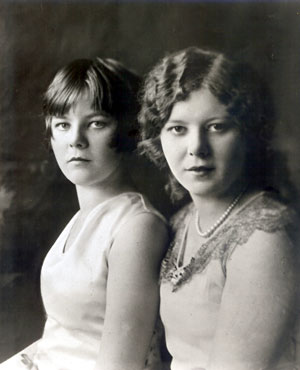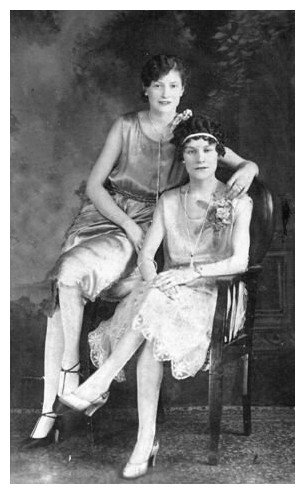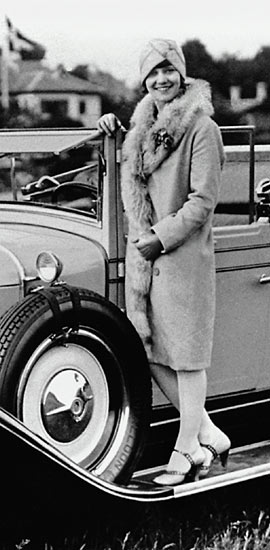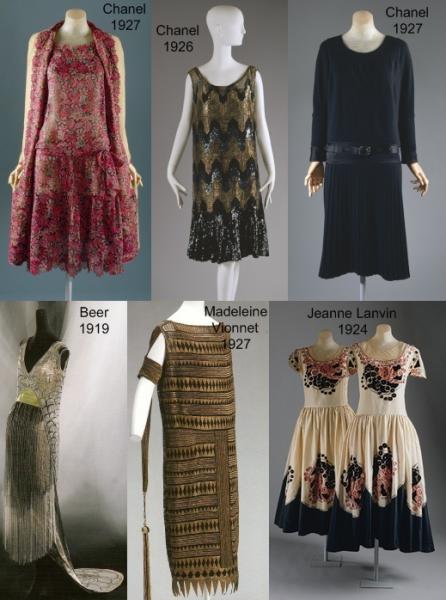 When you think of the 20's your mind immediately goes to the Flapper. But the Flapper style did not actual begin until 1926. The fashionable Flapper had short smooth sleek hair, a shapeless shift type dress and a flat chest.
When you think of the 20's your mind immediately goes to the Flapper. But the Flapper style did not actual begin until 1926. The fashionable Flapper had short smooth sleek hair, a shapeless shift type dress and a flat chest.After the first world war the styles for women became considerable more "mannish". Female dress became loser and less fitted. The bustline was suppressed by special designed Brassieres. One knows as the Symington Side Lacer. It laced on the sides so that it could be tightened for a flattening effect. The Miracle Reducing Rubber Brassiere gave the "desirable flat lines" sought after by young women in the 20s. It was paired with the Miracle Reducing Rubber Reducer, which molded the lines of the figure while reducing it. The garment was "scientifically designed without bones or lacings."
 It is a common misconception that Hems were short throughout the 20's. Actually hem began to creep up to show a bit of the ankle in 1913. In 1918 hems were just below mid calf. Also around 1918 even thought length remained the same, at the calf, the waist actually dropped. Gradually the skirt lengths on dresses gave the illusion of being first long and then shorter with dipping, scalloped and handkerchief hemlines in floating fabrics. It was only in 1925 that skirts rose 14 to 16 inches from the ground making the shorter hemline we associate with the era.
It is a common misconception that Hems were short throughout the 20's. Actually hem began to creep up to show a bit of the ankle in 1913. In 1918 hems were just below mid calf. Also around 1918 even thought length remained the same, at the calf, the waist actually dropped. Gradually the skirt lengths on dresses gave the illusion of being first long and then shorter with dipping, scalloped and handkerchief hemlines in floating fabrics. It was only in 1925 that skirts rose 14 to 16 inches from the ground making the shorter hemline we associate with the era.Fashion also became more accessible at this time. The lines were simplified thus making it easier for the home sewer to create her own styles.
You cannot mention the 20's without talking about Coco Chanel (pictured below in 1920). From her first
Coco Chanel introduced her signature cardigan jacket in 1925 and signature "little black dress" in 1926. Most of her fashions had a staying power, and didn't change much from year to year -- or even generation to generation.
 The Cloche Hat is a fitted, bell-shaped hat that was popular during the 1920s. If you were a cloche hat you told everyone you had short hair. It was only possible to get this style of hat to fit well if you have very short flat hair. It was essential that it cover the forehead. Foreheads were unfashionable at the time. This stykle of hat was very popular and continued to be worn and evolve into the 30's.
The Cloche Hat is a fitted, bell-shaped hat that was popular during the 1920s. If you were a cloche hat you told everyone you had short hair. It was only possible to get this style of hat to fit well if you have very short flat hair. It was essential that it cover the forehead. Foreheads were unfashionable at the time. This stykle of hat was very popular and continued to be worn and evolve into the 30's.Michelle minidolls.com Doll Artist's Workshop



Excellent post! My favorite era of fashion. Thanks for all the photos and history!
ReplyDeleteThank-you for your kind words. I actually learned too in my research! Michelle
ReplyDeletei loved the description. thank you for elaborating this fashion era. the photos are greatly supporting the whole post.
ReplyDeleteNazish
In the following video shot throughout Jerusalem, reportedly in 1918, there are some appearances of women with dresses that fall just below the knee. See 4:48 and 5:09. At 4:48, there are 2 women in the background and 2 near the foreground. At 5:09, the woman entering the screen from the bottom right is wearing a short skirt, but what also seems to be a cloche hat, another item we associate more with the 1920s than the teens.
ReplyDeletehttp://www.youtube.com/watch?v=8k82FgJ8VZk